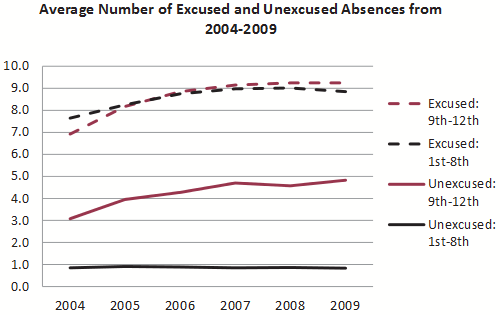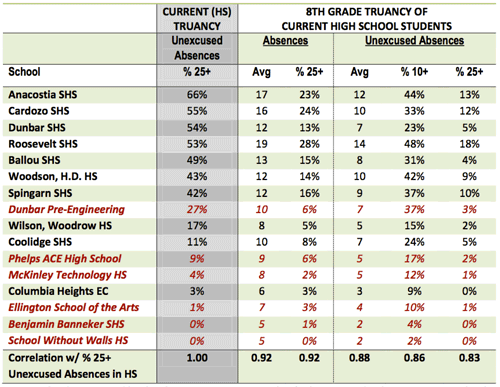Tackling truancy, part 3: The solution is collaboration

Truancy. Image from EducationNext
This is the third installment of a series on truancy in DC schools. Read part 1 and part 2.
Truancy isn’t a new problem, nor one unique to DC. School systems around the country have tried various approaches that leverage state services and civil society to engage the child and their family on many levels. Many have been able to take a bite out of chronic truancy.
In the end, however, truancy isn’t the problem; it is a symptom of social dysfunction that requires a comprehensive social policy response. There’s nothing wrong with treating symptoms; many become a problem unto themselves. However, lasting success won’t come until someday we address underlying issues of poverty, alienation, community collapse, and educational failure.
Before considering those more comprehensive programs, let’s address the common trope of simply employing a “tough love” punitive approach with the children themselves.
Washington State’s punishments haven’t reduced truancy
Washington State passed the so-called “Becca Bill” in 1995, a law that required prosecuting children after 7 absences in a month or 10 in a year. Children could get sentences of up to 7 days in juvenile hall.
In 2005, 15,000 children went to court, and that number hasn’t decreased materially in years. This shows that this policy isn’t solving truancy. There’s no evidence to suggest the numbers declined soon after the law was implemented either; on the contrary, it appears Becca’s Bill may have made things worse, with rates rising consistently through the Aughts.

The results of a punitive approach in Washington State.
Graphic from a report by the Washington State Center for Court Research.
Denver’s approach goes inside the school
Another option is to have disciplinary procedures inside the school for truancy. Many jurisdictions have tried this, including DC. DCPS apathy undermined such an effort here, but Denver’s program is considered a model. Their Student Attendance Review Boards contain representatives of social services, probation, juvenile justice, police, local businesses and civic leaders, school staff, parents, and city officials.
With wide-ranging options derived from the resources of these various organizations, the board is able to develop “contracts” with the child and their family that leverage support services throughout the community to resolve the family’s troubles. Significantly, the cost of this program is rather low; the Denver boards must only convince one out of every 739 truants to stay in school and graduate in order to pay for itself.
DC’s approach: build connections to social service agencies
DC tried a related approach that was unconnected to its in-school court experience: the Truancy Case Management Partnership Initiative (CMPI), which excluded the judiciary, police, and prosecutors, but included CFSA, DCPS staff, and the Healthy Families/Thriving Communities collaborative.
The goal was less a contract-oriented approach than to create “linkage” between children and their families to various services. This would, officials hoped, reduce the pressures the children were experiencing and facilitate attendance.
The pilot met with mixed success. It achieved its intermediate goal of lowering pressure on the families, and the families that qualified were indeed under immense strain. Some have suggested that is reason enough to continue, but the program was terminated after truancy rates did not respond significantly.
There may be reasons for this. In DC, truancy as a pattern is established in 8th grade while this program only addressed high schoolers. Perhaps catching the kids before they develop habits of cutting class would be more effective.
Further, the pilot took on the highest-truancy schools; the program may be effective, and simply unable to handle the peer-truancy feedback loop that has metastasized there. A broader test that began in 7th grade across a range of schools would be a better test of this approach.
Minnesota’s approach: Long-term contact
The “Check and Connect” program developed in Minnesota takes this coordination even further with a long-term case officer approach. If a student is truant or tardy on a regular basis, the program assigns a monitor/mentor. That person is the advocate, mentor, and service coordinator for the child and their family for two years, focusing entirely on preserving and enhancing the student’s attachment to school.
The goal is to prevent a patten where the student oscillates from truancy, to successful intervention, to attendance, to benign neglect by the various institutions, and then back to truancy. As the initial conditions of school, family, and community all encouraged the child to be truant, C&C assumes those conditions will reassert themselves some time after the initial successful intervention. The long-term monitoring tries to prevent the child from returning to that pattern before it begins, allowing positive habits to have a longer period to take hold.
Will Denver’s and Minnesota’s programs work here?
Some combination of the Denver and Minnesota approaches seem ideal, but of course the District is a different context. Not only is it an urban school district, with all the distractions a child could want located along the walk to school, but it is one with a core of extreme poverty.
DC does not have a bell curve income distribution. Concentrated poverty in the eastern third of the city leaves children with few role models in their neighborhoods, and low expectations for themselves. This means there are fewer civic organizations whose services can be leveraged to encourage pro-social behavior, and there are many adults in this communities who are unemployed and unproductive during the same school day the child is being asked to work.
It is unlikely that these facts on the ground will change in a generation. There are few low-skill jobs in the Washington area, and those that exist often require consistent work history and a professional demeanor. After several years of unemployment, it is unlikely that adults who either lack, or possess no more than a high school diploma will ever be employed again. The children of that community must then be saved despite the negative examples all around them, which is a task that few other communities must strive against.
At the same time, the District is one of the wealthiest communities in the nation. It has resources few others can muster, and a large population of socially-conscious residents of means who can be recruited to help. Engagement with the child and family that promotes a sense of personal stake and commitment in education is the answer. It has been done before, successfully, and if DC faces a more difficult challenge it also possesses better tools.


